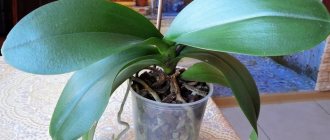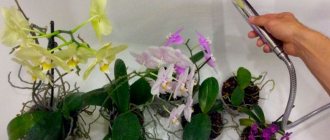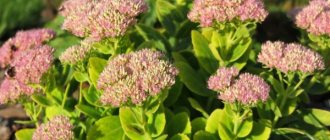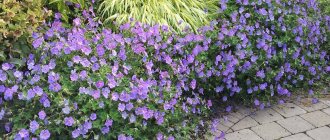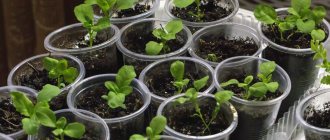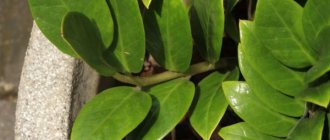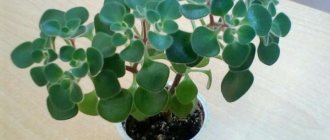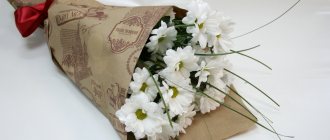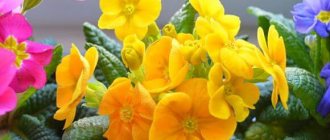Hydrangea is the most beautiful flowering shrub, which today is very popular among gardeners. Some not very conscientious sellers claim that this plant is very unpretentious and does not require special care or special knowledge.
Actually this is not true. Caring for hydrangeas is really not that difficult, but this care must be competent, taking into account all the features of this culture. Otherwise, it may simply not bloom or even die.
about the types of hydrangeas that grow comfortably in our cold climate, as well as the rules for planting and caring for this lushly flowering shrub in the article: “Frost-resistant hydrangeas in your garden.”
In this article we will talk about how to care for hydrangeas from late July to October. This is a very important period in the life of plants, on which the formation of flower buds for the next year, the correct formation of bushes and their normal overwintering depend.
Types and varieties of indoor hydrangea
Hydrangea is a plant whose height reaches one and a half meters. Belongs to the type of subshrubs. Has spreading leaves. They have small notches along the very edge. It is distinguished by very large inflorescences that reach up to 30 cm in length.
Varieties have been bred to create a large palette of colors. Let's look at the most common ones for home floriculture.
- Tree-like. A shrub whose height reaches 3 meters. The leaves are large and fleshy. Bright green hue. The flowers form a spherical sphere and reach a diameter of 25 cm. Flowers are most often colored milky or beige. One of the most unpretentious varieties.
- Large-leaved. The length reaches 2 meters. Suitable for both home growing and greenhouse growing. The leaves are quite large. The shoots are always light green. The variety is resistant to cold, so even in the winter season it feels great on a cold window.
- Paniculata. Looks like a large spreading shrub or small tree. The height reaches 6 meters. The leaves have an elongated shape. And the shoots turn brown with age. The plant is resistant to cold. The inflorescences gradually form a small pyramid. They have shades from milky to blue. By autumn, the flowers acquire a reddish or even brown tint.
Flowers also differ in the color that is inherent in them during flowering. There are varieties:
- red sensation;
- Early Blue;
- Europe;
- star;
- linear and so on.
However, the color of the inflorescences is affected not only by the variety, but also by the composition of the soil. For example, if it is sour, then a blue tint appears in the flowers. If it is more alkaline, then the pigment is pink or red. If the soil is neutral, then you will get boiling white flowers with milky splashes.
Basic information about hydrangea
Hydrangea (Hydrangea - hydrangea) is a beautiful plant from the hydrangea family, which includes 80 types of different flowers:
- shrubs;
- vines;
- mini trees.
Translated from Latin, Hydrangea means “water-filled vessel.” Hydrangea received this name because it loves moisture, and the seed pods of the flower look like miniature pots.
Interesting: Hydrangea is a popular name in the era in which the shrub received its name. One version suggests that it was given in honor of a European princess. And in Japan the plant is called Ajisai - “purple sun”.
Native habitat
In nature, hydrangea grows in southeast Asia and the east: most species of this delicate beauty have settled in Japan and China. Hydrangea also does well on the American continent. The plant was brought to European countries at the end of the 18th century. In Russia, the shrub has taken root and is loved by gardeners: it is increasingly found in the flowerbeds of summer residents and in design solutions for gardens.
Variety of hydrangeas
Hydrangea under natural conditions grows in height by 1–3 m, and the vines have a length of up to 30 m, so the flower is grown in the garden or at the dacha. There are also several types for indoor use. Lovers most often prefer large-leaved hydrangea.
Hydrangeas are:
- evergreen;
- deciduous.
In our latitudes it is preferable to grow the second species. The leaves of the plant are large, oval with a sharp tip and jagged edges, located opposite each other.
Flowers are the striking feature of hydrangeas. They look like balls, panicles, and there are also corymbose-shaped inflorescences. The flower itself is made up of two types of small flowers:
- large sterile around the edges;
- small fertile ones in the center.
There are varieties whose inflorescences consist only of fruiting flowers.
Among the variety of hydrangea species, plants with white flowers predominate, but there are purple, pink, red, and blue ones. The composition of the soil matters for the color of hydrangeas.
Note: flowers of the same color and type differ in soils of different composition.
Plants are able to accumulate aluminum, which gives the inflorescences a blue color. If the acidity of the soil is neutral, the flowers will become creamy, and if the pH deviates to the alkaline side, they will become pinkish-lilac. Low acidity prevents plants from absorbing iron compounds. To grow flowers of the blue spectrum in the country house or in the garden, hydrangea is watered with solutions of aluminum or iron crystals, and rusty pieces of metal are buried. Watering with a solution of potassium permanganate helps to achieve beautiful pink inflorescences.
How to choose hydrangea in a store
It is believed that it is better to purchase flowers in specialized stores.
The first thing to do is look at the stem. It should be dense, elastic, and have an expensive green color. There should be no brown or yellow growths on the leaves. They should be juicy and bright green. If the hydrangea leaves are limp, dry at the edges, or have white or yellow spots on them, you should refuse to purchase.
Carefully examine the hat of flowers. It should be dense, rich, bright colors. If the cap is pale, and the flowers begin to fall when touched lightly, it means that the plants did not receive enough nutrients.
There is one general rule that should be applied to choosing a flower - it should look healthy, nourished and moisturized.
Tenth step: cover the hydrangea for the winter
Tree hydrangea does well without shelter. But the paniculate and large-leaved species will no longer be able to survive without it in winter. To prevent the roots from freezing, hill up with rotted manure. Some gardeners create a fifteen-centimeter protective layer of dry leaves, pine needles, moss and peat. Afterwards agrofibre is laid on it. In such “clothing” hydrangea will winter well.
It is important to remember that young plantings of any variety need to be wrapped for the winter. Because they are not yet strong enough to fight the frost. The covering is still the same - leaves and agrofibre.
Now you know how to care for hydrangea in the countryside so that it pleases everyone with its large and bright inflorescences.
Care and replanting after purchase
It is not recommended to replant hydrangea immediately after purchase. The plant must get used to new conditions. Give her 2 weeks to 1 month to adapt.
In the future, the transplant procedure should be carried out at least once every 3–4 years.
If you ensure annual replanting into larger pots, you can ensure the fullest blooms your hydrangea can produce. The roots of the plant grow in width, so the volume of the pot must match.
Choose a pot that is slightly larger than the diameter of the one you purchased the flower in.
While the plant adapts, you can gradually acquire components for the substrate. You will need 1 part sand, two parts peat, two parts deciduous soil and 4 parts turf soil. All this is mixed and poured into the pot.
Do not forget that during the first stages of life in a new room, hydrangeas will require additional care in the form of fertilizing. It is better to buy mineral fertilizer intended specifically for indoor flowering plants. You can buy it in a specialized store. It is important not to overdo it, so dilute the fertilizer according to the instructions and water the flower in the amount indicated on the package.
Hydrangea does not like direct sunlight, but loves warmth and diffused light. Therefore, it is better to place it on a shaded window.
As soon as the hydrangea gets stronger, you can take care of it and replant it.
At first after purchase, namely, the first two weeks, it is better not to overwater the plant. It is necessary to moisten the soil as it dries. But spraying leaves and flowers from a spray bottle is highly recommended. This procedure must be performed once every two days.
Combination with other plants
The peculiarity of garden hydrangea is that it goes well with both its relatives and other deciduous, flowering and even coniferous plants. These luxurious shrubs look especially harmonious with trimmed barberry, daylilies, and also with low-growing juniper. When planning a landscape design in which paniculate hydrangea will be present, you should pay attention to the viburnum-leaved vesicle, as well as purple-leaved barberries.
This luxurious plant should be planted in the background. This way it will not shade other plants, and will also act as a bright and very beautiful background. Varieties that grow as small shrubs can be planted along garden paths and as hedges.
Caring for hydrangea at home
Lighting for indoor hydrangea
If you choose the right lighting for a flower, it will delight you with its color for a long time.
It is important to choose the right place here. This is necessary so that there is an abundance of color. However, the leaves and flowers of the plant should not be exposed to direct sunlight. Therefore, you need to place the flower at a distance of approximately 3–4 m from the window. In this case, the plant will feel ideal.
Temperature for hydrangea
In terms of temperature, the plant is capricious. The ideal room temperature is between 18 and 23 °C. It is ideal for hydrangeas. The plant should not be exposed to drafts, as it may die.
In winter, this flower can be placed in a room where the temperature is 10 °C. Then the hydrangea will go into a short hibernation and accumulate strength until the new summer season.
Don't forget about watering. The water used to irrigate the land must be at room temperature. Under no circumstances should you use water from the refrigerator.
Watering hydrangea
Caring for hydrangeas in terms of watering should include regularity.
- Hydrangea loves fresh water very much. It can be classified as a moisture-loving plant.
- For irrigation, settled water that is at room temperature is ideal.
- The hotter it is outside the window, the more often you need to irrigate the soil. Don't forget to spray the flowers and leaves with a spray bottle. However, you should not be overzealous with watering. It needs to be renewed as the soil dries out. If you overwater it, the hydrangea can easily rot.
- If the hydrangea leaves begin to turn yellow, this means that it lacks acid. Therefore, sometimes you need to give her a shower with acidic water. To do this, mix 5–8 drops of lemon juice in one liter of water.
Air humidity
Hydrangea loves humidity in the air. Therefore, when the heating season begins and the air is dry, the plant suffers greatly. Therefore, do not forget to spray it with a spray bottle.
If you have a humidifier, place the plant pot nearby. It is enough for hydrangea to spend about half an hour next to a humidifier to stock up on moisture for several days ahead.
Third step: choose a location on the site
When deciding how to care for hydrangea in the country, the choice of planting site is almost the most decisive. The shrub plant will show abundant flowering and good growth only in an area with good lighting. In extreme cases, partial shade can be a compromise option. But the sun's rays should still fall on the plant most of the day.
Colored varieties need light shade at midday. The optimal place would be a flowerbed at the dacha, where the sun's rays reach only until lunchtime. After this, the hydrangea should be in the shade. It is also important that the bush is protected from drafts.
Feeding
In the spring and summer, Hydrangea enters the active stage. At this stage, for enhanced growth, she will need additional amounts of useful minerals and organic substances. Therefore, it is at this stage that it is worth using organic fertilizer.
Unfortunately, if you neglect such care, the plant will stop blooming and develop further.
When watering several times a week, you need to add a few drops of potassium permanganate to the water.
Winter care does not involve the use of fertilizing.
Gardeners say that gibberellin solution is successful in caring for hydrangeas. Approximately 0.1 g per 1 liter of water is used. Thanks to the composition, hydrangea quickly enters the flowering state.
The unique property of hydrangea
This wonderful flower is interesting for its unusual ability to change the color of its petals. You can use this to create a shade with your own hands that harmonizes with the interior of the room. Hydrangea accumulates aluminum, thanks to which its flowers acquire the desired color.
For example, the petals will turn pink if you add lime to the soil. Adding aluminum sulfate will provide a blue color. Acidic soil will give colors brightness and richness, neutral soil will give a noble pallor. For oxidation, use peat, coniferous soil or sawdust. For alkalization, it is better to use ash, lime and chalk.
You can change the color of your hydrangea yourself using little tricks.
To get blue flowers, add potassium alum to the water for irrigation, about 8 grams per 1 liter of water. You can also spray the bush with a solution of 50 g of aluminum citrate per 1 liter of water.
Some gardeners claim that hydrangea with white petals does not change its color due to the properties of the soil or the addition of any substances. Allegedly, only varieties with blue and pink flowers are subject to such changes. Well, a good reason to experiment at home. Moreover, in this way you will not harm the flower itself.
Trimming
The pruning procedure is mandatory in order to maintain the attractive appearance of the plant. For this procedure you will need a well-sharpened knife or pruning shears. The cut should be sharp and even.
During pruning, weak leaves and stems that have begun to dry out or rot are removed. It is also necessary to trim the top of the plant in order to form a more luxuriant crown.
It is ideal to prune twice a year. This is in the fall, when the flowering period has passed, you need to remove weakened leaves and in the spring, when you need to remove weakened shoots.
During the flowering period, the pruning procedure stops. It begins when the first faded flowers or leaves appear. They are the ones that need to be removed so that the plants do not rot.
Landing
It is recommended to plant hydrangeas in central Russia at the onset of early spring; in the fall this can be done only in those regions where there are no harsh winters and only if the seedling has well-developed roots. Before spring planting, you need to trim the roots a little and it is advisable to remove all annual shoots. Since hydrangea’s roots are not capable of penetrating deep layers of soil, it is advisable to exclude proximity to plants that have a superficial type of root system. Since a struggle for moisture and nutrients may begin, which may result in weakened crops that do not produce the desired flowering.
Planting hydrangeas as a hedge
When planting single hydrangea bushes, for each one you need to prepare a hole 35–40 cm deep, 50–70 cm wide, its volume should be no less than the crown of the plant. If you plan to plant a hedge, then you need to dig a strip, the width of which will be equal to one meter. The distance between bushes should be left from 1.5 to 2.5 meters, depending on the plant variety.
Fertilizers must be added to the hole in the form of:
- urea;
- superphosphate in granules;
- potassium sulphide;
- organics.
Important! After such planting, the plant will have enough of these fertilizers for two years, and then it will need to be fed several times a season.
Algorithm of actions when landing:
- Remove the plant shoot from the pot with a lump of earth and carefully shake it off;
- Spread the roots and lower them into the prepared hole;
- Cover with soil and fertilizers so that the root ball protrudes slightly above the level of the site;
- Compact and water the soil generously.
- Do mulching.
Mulch is needed to keep the soil moist longer, which is very important for normal hydrangea growth. For it you can use pine needles, various types of sawdust and peat. The optimal thickness is about 10 cm. In summer, the mulch should be loosened 2-3 times.
In the first year after planting, you should not expect lush flowering of the plant, so there will be no quick decorative effect. The solution may be to plant a 4-5 year old seedling, which is already capable of producing large inflorescences.
Rest period
The dormant period of hydrangea begins in the cold season. As a rule, during autumn frosts. Plants go dormant, begin to consume less moisture and stop blooming. To allow the plant to gain strength before the next season, it must be placed in a room with a temperature of no more than 10 degrees. Do not forget about watering as the soil dries out.
Hydrangea will resume its vitality in late March - early April, when the sun begins to actively warm up.
Reproduction
Hydrangea can be propagated in various ways. Some are more, some are less effective. Let's look at the nuances of each method.
Propagation by cuttings
Propagation by cuttings is the easiest way. The most favorable time for this is January or February.
Take a closer look at the root shoots. Cut the cuttings so that there are no more than three nodes on the branch. Their length should be approximately 8 cm. All leaves should be removed from the bottom of the cut root. The upper leaves should be shortened exactly by half.
The cut on the lower side must be treated with a special root stimulator, which is sold in specialized stores.
The cuttings must be planted in a specially prepared substrate, which consists of peat and sand. Provide maximum humidity, which will promote rapid root formation. Ideal temperature is up to 20 degrees.
Some housewives advise covering the cuttings with special glass jars. However, once a day you need to leave the plant to air for several hours, removing the glass protection. The plant needs constant moisture, so the soil needs to be watered and the leaves should be sprayed with a spray bottle.
After just one month, the cuttings can be planted on prepared peas.
Reproduction by dividing the bush
Dividing the bush is another common method. However, you need to act with caution so as not to spoil the entire bush.
The shoots are evenly shortened. The bush is divided into several parts, carefully freeing the roots. Parts of the plant need to be distributed into different pots into a specially prepared adversary and watered.
You can apply a mulching procedure, which is designed to root the plants faster. It is better to carry out this procedure in the spring so that by autumn the plant feels comfortable in the pot.
Propagation by seeds
When growing seeds, the procedure must be carried out already in February.
- Prepare the soil, which consists of turf and humus.
- Additionally, admixtures of peat or sand can be added to it.
- Purchase special containers that are designed for growing.
- Scatter hydrangea seeds on top. They do not need to be buried in the ground.
- Water the soil well.
- Then you need to cover the container with cling film or glass. Every day you need to ventilate the crops and moisten them with a spray bottle. Remember to keep the soil mostly moist, but not wet.
- As soon as the first shoots appear, the cling film can be removed.
When two leaves appear, they need to be picked in a container.
Reproduction by layering
This type of propagation is best done in March. Used for plants that grow in open ground. However, it can also be used for home flowers.
- The soil around is dug up and compared.
- Small grooves are made to a depth of 2 cm. Approximately one shoot is placed in them. By the way, the shoots need to be cut off from the bottom of the bush.
- They are laid parallel to the ground and covered with earth.
- Then you need to constantly spray the area with a spray bottle to achieve adequate moisture.
- As soon as the roots appear, you need to make a constriction of soft wire. It is carried out in three turns.
- The more the wire is pressed, the faster roots will appear from this place.
By the end of summer, several months after the start of reproduction, several young shoots appear on the cuttings. Once they reach a height of 20 cm, they can be transplanted into a separate pot.
Diseases and pests
Hydrangea is prone to diseases, which form on it with surprising frequency.
- Gray rot. Appears on the leaves if you overdo it with moisture. Reduce watering and make it a rule to treat the flower with a special Bordeaux mixture.
- Spider mite. When the air is dry, on the contrary, spider mites or aphids appear on the plant. To destroy this scourge, you need to water the hydrangea with a soap solution or a special product from the store.
- Downy mildew. Appears at high humidity. Eliminated through the use of drugs that contain copper.
- Nematode. A nightmare for hydrangeas. If the plant is affected by more than 50%, then, unfortunately, it cannot be saved and will have to be thrown out.
Preparing for winter
Before sending the hydrangea into hibernation, it must be prepared on the eve of the onset of cold weather.
The plant cannot overwinter in Russian winter conditions without appropriate insulation. This also applies to indoor hydrangeas. You should not place hydrangea on an open balcony where the temperature is below 0 degrees. The ideal temperature for wintering hydrangea is +10 °C.
Before you prepare your hydrangea for winter, you need to do the appropriate pruning. To do this, faded flowers, dry or, conversely, too limp leaves are removed. If there are individual shoots that have grown in length but are very dry, or vice versa, they show signs of rot, they also need to be cut off.
After the procedure is completed, the plant must be brought to a new watering regime. Now you need to water less often so that the hydrangea does not rot by winter.
Prepare a room to place the flower. The temperature in it should be between 8–15 degrees, no higher and no lower. Place the plant in this room and make sure that it will not be exposed to drafts.
Changing the color of hydrangea
Not all hydrangea owners are happy with its color. You may not know, but it's easy to change.
- Make the soil more alkaline. Then bright pink flowers will appear along with a blue or white tint.
- If you make the soil more acidic or regularly water the plants with water and a few drops of lemon juice, you can achieve a blue tint.
- If the soil is in normal condition and the plant is regularly watered with water with the addition of a small amount of potassium permanganate, then the hydrangea will acquire a white tint.
Difficulties in growing hydrangea
Leaves are drying
If the leaves of a hydrangea dry out, it means that it does not have enough moisture. Give preference to watering with a spray bottle, which should be done daily. Also, do not forget about ventilating the room.
Watering should be done as the soil dries out. Turn on a humidifier near the hydrangea for several hours.
The leaves are falling
If leaves fall, then, unfortunately, this is also evidence of improper care. Falling from dryness indicates a lack of moisture and the proper amount of nutrients.
If the leaves simply wither and fall off, most likely the hydrangea is not getting enough sunlight and warmth. Therefore, raise the room temperature to the desired level.
What to do if the hydrangea has withered
If the hydrangea has wilted by 40%, you can try to revive it. To do this, water it with water containing potassium permanganate. Additionally, copper sulfate and other fertilizers are diluted and poured into the soil.
If it was not possible to rehabilitate the hydrangea, you should say goodbye to it. And the housewife needs to analyze what caused the plant to wither so quickly.
Hydrangea does not bloom, what to do
The plant will bloom if the following conditions are met.
- When the rest period ends.
- It was properly prepared for winter.
- Receives the proper amount of nutrition and feeding.
- All flower diseases were removed.
If you missed any of these points, then, most likely, this is why the hydrangea does not bloom. However, the reason may lie in completely different factors. For example, the roots were damaged during transplantation. The plant directs all its forces to restore their integral structure and not wither. Therefore, flowering is temporarily delayed.
Many people call hydrangea a capricious plant. After all, to care for it you need to very correctly select the necessary standards for temperature and humidity indicators. However, a housewife who is not afraid to mess with hydrangea and is ready to care for it both summer and winter can decorate her home with an incredible color that will delight you all spring, summer and autumn.
Step six: periodically loosen the soil
Now let's move on to how to care for hydrangea in the country during its active period. During the season, you need to loosen the soil around the plant twice to a depth of about six centimeters. This is best done after weeding and watering. Typically, hoe blades with long teeth are used to provide air flow to the roots.
To retain moisture, gardeners practice mulching around the tree trunk. It is recommended to use old sawdust, pine needles, peat and moss. They will save moisture and get rid of weeds. Each layer should be approximately five centimeters thick. For example, if you add mulch in the spring, it will perfectly retain its properties until the fall. Experienced gardeners prefer this method of soil care. Because it is guaranteed to free you from constant loosening and weeding. You will only need to water and fertilize.
